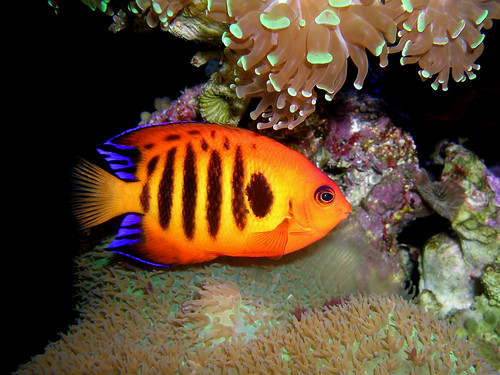First Monday of the year and the time for science talk is here once again. Time to brighten your day with selections from science sites across the globe. New discoveries, new takes on old knowledge, and other bits of news are all available for the perusing in today's information world. Today's tidbits some dinosaurs shook the tail feathers for a mating show, first meteorite linked to Martian crust, a new way to study permafrost soil above and below ground, terrace farming unearthed at ancient desert city of Petra, and a study links post-infectious hydrocephalus to rain fall in East Africa.
Pull up that comfy chair and grab a spot near the fire. There is always plenty of room for everyone. Another session of Dr. Possum's science education, entertainment, and potluck discussion is set to begin.
Featured Stories
In much the same way as peacocks of today some feathered dinosaurs shook their tail feathers in a mating show.
Individual vertebrae at the base of an oviraptor’s tail were short and numerous, indicating great flexibility. Based on dissections of modern reptile and bird tails, (researcher) Persons’ reconstruction of the dinosaur’s tail muscles revealed oviraptors had what it took to really shake their tail feathers.
Large muscles extended far down the tail and had a sufficient number of broad connection points to the vertebrae to propel oviraptors’ tail feathers vigorously from side to side and up and down.
Oviraptors were two-legged dinosaurs that had already gone through major diversifications from the iconic, meat-eating dinosaur family. Oviraptors were plant-eaters that roamed parts of China, Mongolia and Alberta during the Cretaceous period, the final age of the dinosaur.
Meteorites on Earth may have origins in many parts of space. The first
meteorite linked to the Martian crust is now described.
...researchers have identified a new class of Martian meteorite that likely originated from Mars’s crust. It is also the only meteoritic sample dated to 2.1 billion years ago, the early era of the most recent geologic epoch on Mars, an epoch called the Amazonian. The meteorite was found to contain an order of magnitude more water than any other Martian meteorite.
As the climate changes scientists seek to learn more about
permafrost and what will be the end result of the carbon stores in that piece of the planet.
To characterize the land surface, they used data from a remote sensing device called LiDAR, which is short for Light Detection And Ranging. The device was mounted on a Cessna aircraft. It uses light to measure the microtopography, which controls water drainage in the Barrow region.
The scientists also used three tools to explore the hidden world below the surface. Ground-penetrating radar was pulled from one end of the plot to the other. They set up a string of electrodes at different locations to conduct electrical resistance tomography measurements. Electromagnetic data was collected along more than a dozen lines that spanned the length of the plot. The scientists also collected point measurements of temperature, moisture, and other properties at several locations to verify the data from the remote-sensing tools.
During the first century the desert city of Petra experienced a heyday of
terrace farming
The successful terrace farming of wheat, grapes and possibly olives, resulted in a vast, green, agricultural “suburb” to Petra in an otherwise inhospitable, arid landscape. This terrace farming remained extensive and robust through the third century. Based on surface finds and comparative data collected by other researchers in the area, however, it is clear that this type of farming continued to some extent for many centuries, until the end of the first millennium (between A.D. 800 and 1000). That ancient Petra was under extensive cultivation is a testament to past strategies of land management, and is all the more striking in light of the area’s dry and dusty environment today.
.
In Africa the occurrence of hydrocephalus (a build up of fluid within the brain) results often from infection of the brain (encephalitis).
Using satellite-derived climate data on rainfall in Uganda during a six year time period, these scientists were able to overlay data collected regarding the cases of infection-induced hydrocephalus. Their study found that the illness leading to hydrocephalus appeared more prevalent before and after the two major rainy seasons, indicating a correlation between rainfall and hydrocephalus in children.
Knucklehead's Photo of the Week
Pygmy Angel below Green Torch coral

©Knucklehead, all rights reserved, presented by permission. (Click on the image to see more in the same series.)
Other Worthy Stories of the Week
The 5 most impressive mountain climbs of 2012
Comet heads our way for celestial show in 2013
The toughest animal on Earth...and in space
Celestial flybys set to thrill
As the globe warms, Alaska is cooling down
Astrophysicists make stellar discovery about galaxies far, far away
Carbon in Vesta's craters suggests possibility asteroids brought carbonaceous material to protoearth
New understanding of nerve damage caused by spinal cord injury may lead to better treatment
Cup color influences the taste of hot chocolate
Study reveals the extraordinary properties of ordinary glass
A new approach to assessing future sea level rise from melting ice sheets
Space travel is harmful to the brain
Itchy wool sweaters explained
For even more science news:
General Science Collectors:
Alpha-Galileo
BBC News Science and Environment
Eureka Science News
LiveScience
New Scientist
PhysOrg.com
SciDev.net
Science/AAAS
Science Alert
Science Centric
Science Daily
Scientific American
Space Daily
Blogs:
Cantauri Dreams space exploration
Coctail Party Physics Physics with a twist.
Deep Sea News marine biology
List of Geoscience Blogs
Science20.com
ScienceBlogs
Space Review
Science Insider
Scientific Blogging.
Space.com
Techonology Review
Tetrapod Zoology vertebrate paleontology
Wired News
Science RSS Feed: Medworm
The Skeptics Guide to the Universe--a combination of hard science and debunking crap
At Daily Kos:
This Week in Science by DarkSyde
Overnight News Digest:Science Saturday by Neon Vincent. OND tech Thursday by rfall.
Pique the Geek by Translator Sunday evenings about 9 Eastern time
All diaries with the DK GreenRoots Tag.
Astro Kos
SciTech at Dkos.
NASA picture of the day. For more see the NASA image gallery or the Astronomy Picture of the Day Archive

NGC 1097, NASA, Public Domain


